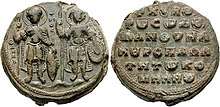Manuel Komnenos (kouropalates)
| Manuel Komnenos | |
|---|---|
 Lead seal of Manuel Komnenos with his title of kouropalates, showing the military saints Demetrius of Thessalonica and Saint George | |
| Native name | Μανουήλ Κομνηνός |
| Born | c. 1045 |
| Died | 17 April 1071 |
| Battles/wars | Campaigns against the Seljuq raids into Asia Minor |
| Relations | John Komnenos (father), Alexios I Komnenos and Isaac Komnenos (brothers) |
Manuel Komnenos (Greek: Μανουήλ Κομνηνός, Manouēl Komnēnos; c. 1045 – 17 April 1071) was a Byzantine aristocrat and military leader, the oldest son of John Komnenos and brother of emperor Alexios I Komnenos. A relative by marriage of emperor Romanos IV Diogenes, he was place din charge of expeditions against Turkish raids in 1070–1071, until his sudden death by illness in April 1071.
Life and career
Manuel was the first-born child of John Komnenos, and his wife Anna Dalassene.[1] The date of his birth is unknown, but he was described as a youth in 1068, so he must have been born around 1045.[1] Already as a child, as was customary for children of the Byzantine aristocracy, he was trained in war by his father, who at the time was domestikos ton scholon (commander-in-chief) of the Eastern field army.[2] By 1068 Manuel held the high court rank of protoproedros. In that year he married a relative of Emperor Romanos IV Diogenes (r. 1068–1071), who on the occasion raised him further to kouropalates and appointed him to the military post of protostrator.[3] The couple had at least one daughter, most likely named Anna after Manuel's mother.[4]
As protostrator, Manuel confronted the raids of the Seljuq Turks into eastern Asia Minor. In one such skirmish in 1070, he foolhardily pressed ahead to the Turkish camp, and was captured after a bitter struggle. His loss led to the defeat of his army and the capture of his two lieutenants and brothers-in-law, Michael Taronites and Nikephoros Melissenos.[5] Brought before the Turkish leader, a certain Chrysoskoulos, Manuel managed to inflame his ambition and raise him in revolt against his nominal sovereign, Sultan Alp Arslan (r. 1063–1072). Indeed, Chrysoskoulos accompanied his captives to the Byzantine capital, Constantinople, where Romanos IV received them with much honour.[6]
In spring 1071, Manuel and Chrysoskoulos went on campaign together against the Seljuqs, but on the way Manuel fell heavily ill with an ear infection in Bithynia. His mother hurried to his side at the monastery of Theotokos of Alypos on Mt. Azalas, but arrived barely in time for him to bid her farewell before he died.[6] According to the late 12th-century typikon of the Monastery of Christ Philanthropos, founded by Empress Irene Doukaina, wife of Manuel's younger brother Alexios I Komnenos (r. 1081–1118),[7] he died on 17 April (the day of his commemoration).[8] In the typikon, he is listed as a sebastos, but this is an anachronism reflecting later practice.[8]
References
- 1 2 Varzos 1984, p. 61.
- ↑ Varzos 1984, p. 61 (note 4).
- ↑ Varzos 1984, pp. 61–62.
- ↑ Varzos 1984, pp. 63–64.
- ↑ Varzos 1984, pp. 62–63.
- 1 2 Varzos 1984, p. 63.
- ↑ Kouroupou & Vannier 2005, pp. 41ff..
- 1 2 Kouroupou & Vannier 2005, p. 60.
Sources
- Kouroupou, Matoula; Vannier, Jean-François (2005). "Commémoraisons des Comnènes dans le typikon liturgique du monastère du Christ Philanthrope (ms. Panaghia Kamariotissa 29)" [Commemorations of the Komnenoi in the liturgical typikon of the Monastery of Christ Philanthropos (ms. Panaghia Kamariotissa 29)]. Revue des études byzantines (in French). 63: 41–69. doi:10.3406/rebyz.2005.2305.
- Varzos, Konstantinos (1984). Η Γενεαλογία των Κομνηνών [The Genealogy of the Komnenoi] (PDF) (in Greek). A. Thessaloniki: Centre for Byzantine Studies, University of Thessaloniki. OCLC 834784634.